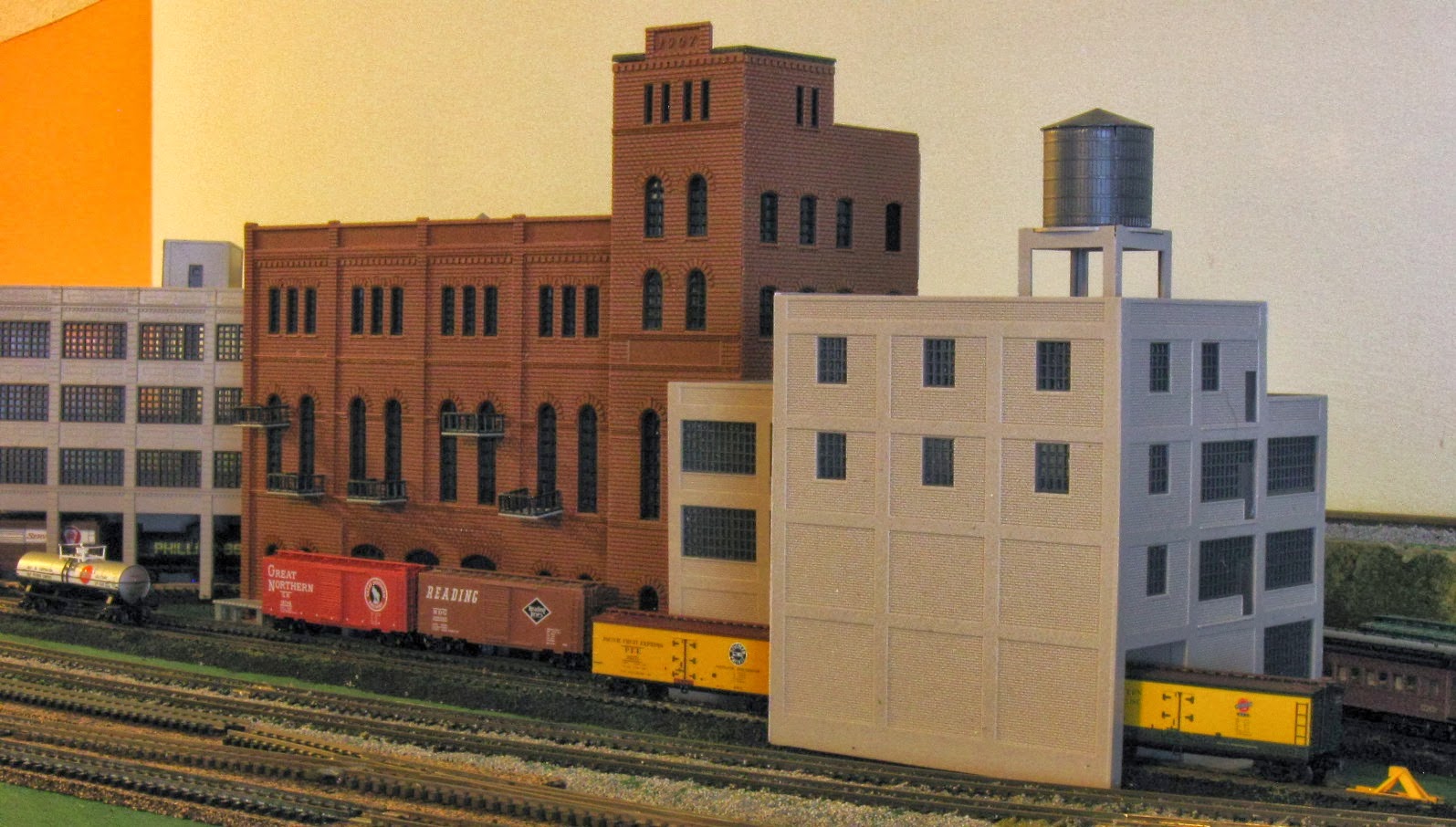I
have moved the construction concentration up the line and wired and ballasted (gray)
about 25' of double track mainline through Camden.
Then
I cinder ballasted the 2 holding tracks behind the industrial area and the 3
Camden industrial spurs.
I
still need to lay the yard leads (waiting for 2 Peco large radius switches to
arrive) and then we can begin to plan the connection to the existing Woodbury,
Westville, Brooklawn portion of the railroad. The target is to be running the
whole railroad by Christmas.
Now
that the initial construction end is in sight, I have started attempting to
figure out which of my 758 freight cars will realistically make it onto the
layout on a regular basis. (I am selling off the excess cars.) That presents 3
main issues:
1) Number of cars that will fit on
the railroad;
2) Ratio of railroads represented and
3) Percentages of car types.
1) To calculate/guess at how many cars will fit I figured I would calculate the
yard and sidings capacity and figure on a 50% occupancy to not clog up the
railroad (it is nearly impossible to switch a yard to make up a train where all
the yard tracks are almost full):
123 cars fit in the Camden Pavonia yard
10 cars in Camden's 2 additional storage
tracks
15 cars Camden (3) industrial spurs
29 cars
fit in the Woodbury yard (where 3 branches join to drop off cars for
consolidation (and icing)
20 cars Woodbury 5 industrial spurs
20 cars Westville 5 industrial spurs (will
increase when I get around to building the Texaco refinery)
-----
217 / 2 = ~
108 cars
2)
Ratio of railroads represented:
The
PRSL was a state forced shotgun marriage between the PRR and the RDG which
covered the entire South Jersey area. PRR owned 2/3 so they pretty much ran the
show for 2 out of 3 years. The PRSL was somewhat strange because it was a
north-south (and east) railroad with no connections on the southern side. CNJ
had an interchange mid-point but the main connection with the outside world was
Camden to Philadelphia on the north end (some traffic got routed on the PRR
north to Trenton and NYC from Camden). I am primarily modeling early 1950s when
south Jersey was loaded with farms and Campbell Soup was a major Camden
destination (with most reefers being iced/re-iced in the Woodbury yard).
The PRSL supposedly had no freight cars (but did have some cast off hopper cars to hand-load the steam engines and ex-PRR work cars that they re-stenciled "PRSL").
The PRSL supposedly had no freight cars (but did have some cast off hopper cars to hand-load the steam engines and ex-PRR work cars that they re-stenciled "PRSL").
I
am guessing I should use:
30%
PRR;
15% Reading
5% to each nearby roads: CNJ, B&O, LV, Erie, NYC, C&O, N&W (2 power plants), and FGE (/PFE: need to steal their reefers).
DuPont and Shell also had plants on-line
That leaves about 15% for misc. railroads.
15% Reading
5% to each nearby roads: CNJ, B&O, LV, Erie, NYC, C&O, N&W (2 power plants), and FGE (/PFE: need to steal their reefers).
DuPont and Shell also had plants on-line
That leaves about 15% for misc. railroads.
3) Car TYPE ratios. This
is tricky since there were 2 power plants fed by the PRSL. Also every town had
1 or 2 coal dealers (remember those octopus coal furnaces in your basement.)
Hoppers dominated the up to 100 car trains running through Woodbury so I
probably need at least 50% hopper cars.
Multiple refineries were on line. Texaco is in Westville (and Mobil Oil was on the Penns Grove branch). So I am guessing 20 tankers.
20 reefers (remember Campbell Soup and the south Jersey farms.)
South Jersey also had Owens Corning glass plants requiring sand as did the cement mixing businesses trying to keep up with post WWII road construction. Therefore I need about 10-15 gondolas and covered hoppers.
Box cars were everywhere (and a colorful part of the trains) so I figure about 40. That puts me at 140 which is about 30 over estimated capacity so I guess I will slim down and keep the calculated car type ratios. Once I begin operations that should highlight any needs to change the type ratios.
Multiple refineries were on line. Texaco is in Westville (and Mobil Oil was on the Penns Grove branch). So I am guessing 20 tankers.
20 reefers (remember Campbell Soup and the south Jersey farms.)
South Jersey also had Owens Corning glass plants requiring sand as did the cement mixing businesses trying to keep up with post WWII road construction. Therefore I need about 10-15 gondolas and covered hoppers.
Box cars were everywhere (and a colorful part of the trains) so I figure about 40. That puts me at 140 which is about 30 over estimated capacity so I guess I will slim down and keep the calculated car type ratios. Once I begin operations that should highlight any needs to change the type ratios.






Looking good Rick. The guys I operate regularly with have a method that is escaping me right now but I'll see them next week and get the reference material and send to you. It does calculations based on online industries (and perhaps offline as well). Generally, that's where you'd start from and go from there with traffic movement.
ReplyDelete